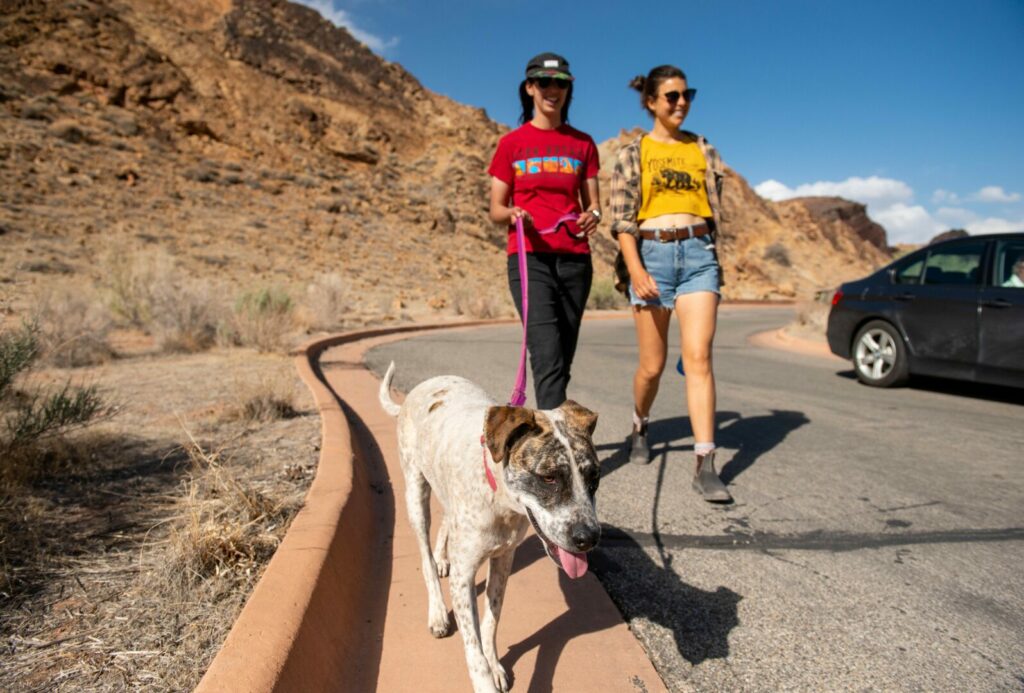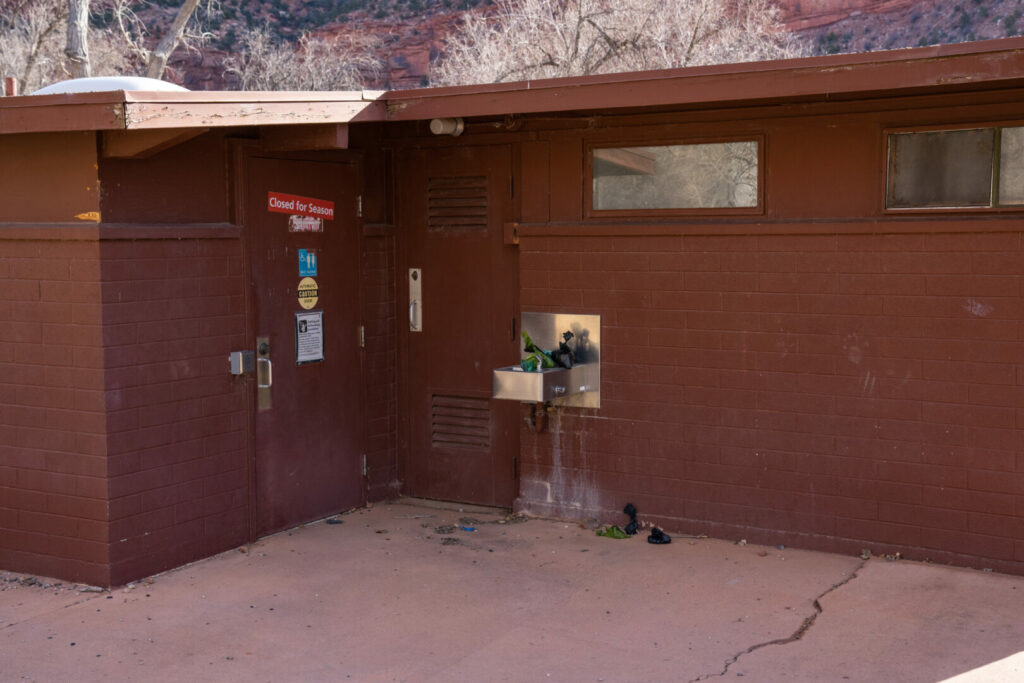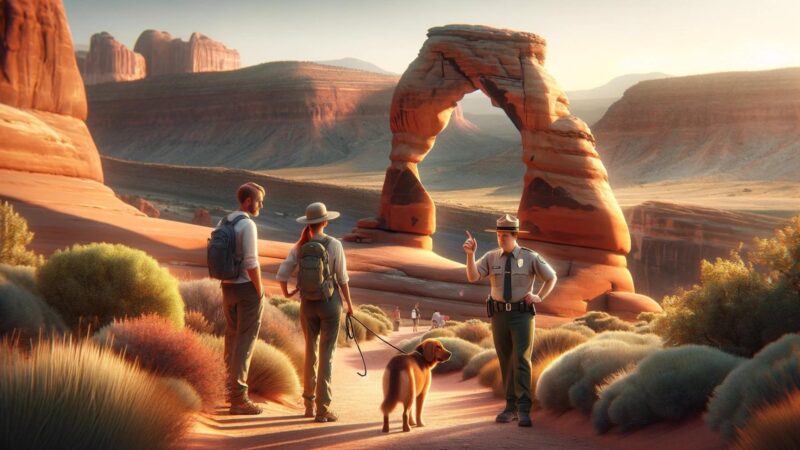Table of Contents Show
Exploring the outdoors with our dogs brings smiles and enjoyment to us all. We love hitting the trails or paddling rivers with our pups. But only when it’s safe and recommended.
Today, we’re looking at the least pet-friendly national parks and why you should leave your furry friends at home. This will make your experience and theirs more pleasant. Let’s dive in!
Are Dogs Permitted At National Parks?
Some national parks are excellent places to bring your dog. Leashed pets are welcome on trails, and campgrounds permit them when staying overnight.
For example, in Acadia National Park, pets are welcome on over 100 miles of trails and at the Blackwoods, Seawall, and Schoodic Woods campgrounds.
However, not every park has the same rules about pets. Other parks, like Carlsbad Caverns National Park, aren’t conducive to pets.
It’s important that you read the latest information before bringing your dog to a national park.
Make sure to call the visitor center and ask a ranger where dogs are permitted or check the National Park Service website.
Why Do People Take Their Dogs To National Parks?
For solo travelers, a dog provides companionship. Sharing in hiking or paddling experiences with your pet deepens your bond. These activities are also healthy for both you and your pet.
Dogs can interact with other people and dogs they meet along trails and in campgrounds. These types of interactions are needed to have a correctly socialized and friendly dog.
We know our dog loves going for hikes and taking in new smells. Also, why would we leave her locked in the camper when she could explore with us?
The 5 Least Pet-Friendly National Parks
If you plan on heading out to these five national parks, we suggest leaving your pets at home or boarding them if you’ll be gone for several days.
While you might be allowed to bring your dog inside the park, they might need to remain confined to your car, on paved public areas, in parking lots, or within 100 feet of any road.
This likely won’t be a fun experience for you or your furry friend; it can even be dangerous depending on the weather.
Yellowstone National Park
Since 1948, over one million people have visited Yellowstone annually. Some years have seen over four million visitors. Yellowstone National Park is known for its 10,000 geothermal features like geysers, hot springs, mud pots, and fumaroles.
The Steamboat Geyser is the tallest active geyser in the world, and the Yellowstone Caldera is the largest supervolcano in North America. Visitors also love wildlife viewing here, often seeing bison, elk, bighorn sheep, moose, black bears, or grizzly bears.
Why It’s Not Pet Friendly: While Yellowstone National Park is one of the most visited national parks and our country’s oldest, we don’t recommend bringing your dog. They must stay within 100 feet of roads, parking areas, and campgrounds.
Basically, they have to stay in the car or camper. The beautiful and unique landscape that draws millions of visitors yearly isn’t pet-friendly, as your pup won’t understand the volatile nature of the park’s hot springs and geysers.
Bison and bears also roam freely through this national park, making it one of the least pet-friendly options in the U.S.
Rocky Mountain National Park
Rocky Mountain National Park has over 300 miles of hiking trails and offers amazing wildlife viewing opportunities. Sixty mountain peaks are over 12,000 feet high, showcasing stunning scenery, including glacial valleys, alpine tundras, and evergreen forests.
Visitors enjoy hiking to Bear Lake, Dream Lake, and Alberta Falls. More than four million people have visited Rocky Mountain National Park in seven of the last eight years.
Why It’s Not Pet Friendly: Your dog can’t accompany you on any of the Rocky Mountain National Park’s trails. If you’re going for a scenic drive and bring Fido along, you can stop for a picnic. But he must remain on a leash at all times.
Dogs are permitted on leash at the campgrounds if you’re camping inside the park. Just leave them in your camper if you’re going to hit the trails.
Arches National Park
One of the Utah Big Five national parks, Arches is on the southeastern side of the state. It features thousands of natural stone arches, pinnacles, rock fins, and balanced rocks that lure over a million visitors annually.
Due to the lack of light pollution, Arches National Park is also an International Dark Sky Park where stargazing is at its best.
Why It’s Not Pet Friendly: Pets aren’t allowed on any hiking trails, anywhere off-trail, or at any overlooks in Arches National Park. If you bring your dog, you must leave him in the car or at the campground.
Like Rocky Mountain National Park, Arches does allow leashed pets at picnic sites. It’s also important to consider the heat at Arches. With temperatures regularly exceeding 100°F, this isn’t the place for pets.

Big Bend National Park
Big Bend National Park in Texas is one of the most remote national parks and, thus, one of the least visited locations. About half a million people visited in 2022.
Big Bend is known for its diversity. From the plants and animals to the landscape, traveling through the 1,252 square miles of the park gives you opportunities to see more than 1,200 species of plants, 11 species of amphibians, 56 species of reptiles, 40 species of fish, 75 species of mammals, over 400 species of birds.
Volcanic activity, vertical faulting, and erosion have shaped the landscape into a geological wonderland.
Why It’s Not Pet Friendly: Not only are dogs not allowed on any of the trails in Big Bend National Park, but they’re also not permitted to be left alone in the campgrounds. If you want to go exploring, they can only go where your car goes, but like the campgrounds, you can’t leave them unattended in your car.
Pets also can’t go into Mexico at the Boquillas Port of Entry. Finally, the remote location of this park isn’t ideal for pet owners. If something were to happen to your pet, help would be far away.
Zion National Park
Another Utah national park is Zion, located on the southwestern side of the state. It’s one of the most-visited national parks, with over five million visitors in 2021 and over 4.6 million in 2022.
It’s known for its massive sandstone cliffs and excellent hiking opportunities. Angel’s Landing and the Narrows are two bucket list hikes for many avid outdoor enthusiasts. Zion National Park is also one of the best locations for canyoneering in the country.
Why It’s Not Pet Friendly: Like these other national parks, Zion National Park isn’t pet-friendly because dogs aren’t allowed on many trails. While Zion is known for its abundant and varied hiking trails, the Pa’rus Trail is the only one open to bikes and pets.
It’s paved, making it wheelchair accessible, which is terrific for those with mobility challenges. But the trail itself is easy and won’t entertain avid hikers.
Visitors must use the bus system, which is not pet-friendly, to get to other parts of the park.

Please don’t be these people and throw your dog poop in an actual trash can.
Tips For Visiting National Parks With Pets
Don’t bring your pet without a collar and leash. If you’re hitting the trails in Shenandoah, Petrified Forest, or any other national park where pets are permitted, you won’t be able to leave the car without these two items.
Remember your furry friend when you pack your bag for a day at a national park. Include a bandana that you can wet if temperatures get warm. Bring plenty of water and snacks for both you and your pet.
Finally, include a dog first aid kit. Hopefully, you’ll never use it, but you’d hate to be caught without it in a time of need!
We can’t stress enough how critical it is to check the NPS website for each national park before your road trip or excursion. If you plan to take a week to explore the Utah Big Five, check each location (Zion, Bryce Canyon, Capitol Reef, Canyonlands, and Arches) to decide whether or not it’s worth it to bring Fido along.
If the park you are visiting is dog friendly, check if they have the B.A.R.K ranger program and get your pup a souvenir of their own.
Do Your Research Before Visiting A National Park With Your Furry Friend!
Our national treasures are protected for the enjoyment of the public. We love visiting these parks, monuments, historic sites, and memorials.
But we only bring our dogs along when it’s safe and enjoyable. They aren’t going to like staying in the car, nor are we. So we’re all better off if they stay at home when we visit places like Yellowstone or Rocky Mountain.
Have you visited any national parks with your pets? Which ones were your favorites?







Pets are allowed in campgrounds in Big Bend. I agree that they are best left home as they aren’t allowed on trails, it can be extremely hot, snakes and lots of spiky plants.
What about cats? I have a cat who loves to go and she is either in a playpen, our coach or on a leash with halter. Is there a list of “no cat” parks? Thanks!
Check with each National Park that you want to visit but I think it is safe to assume that everywhere a dog is allowed, a cat would be allowed!